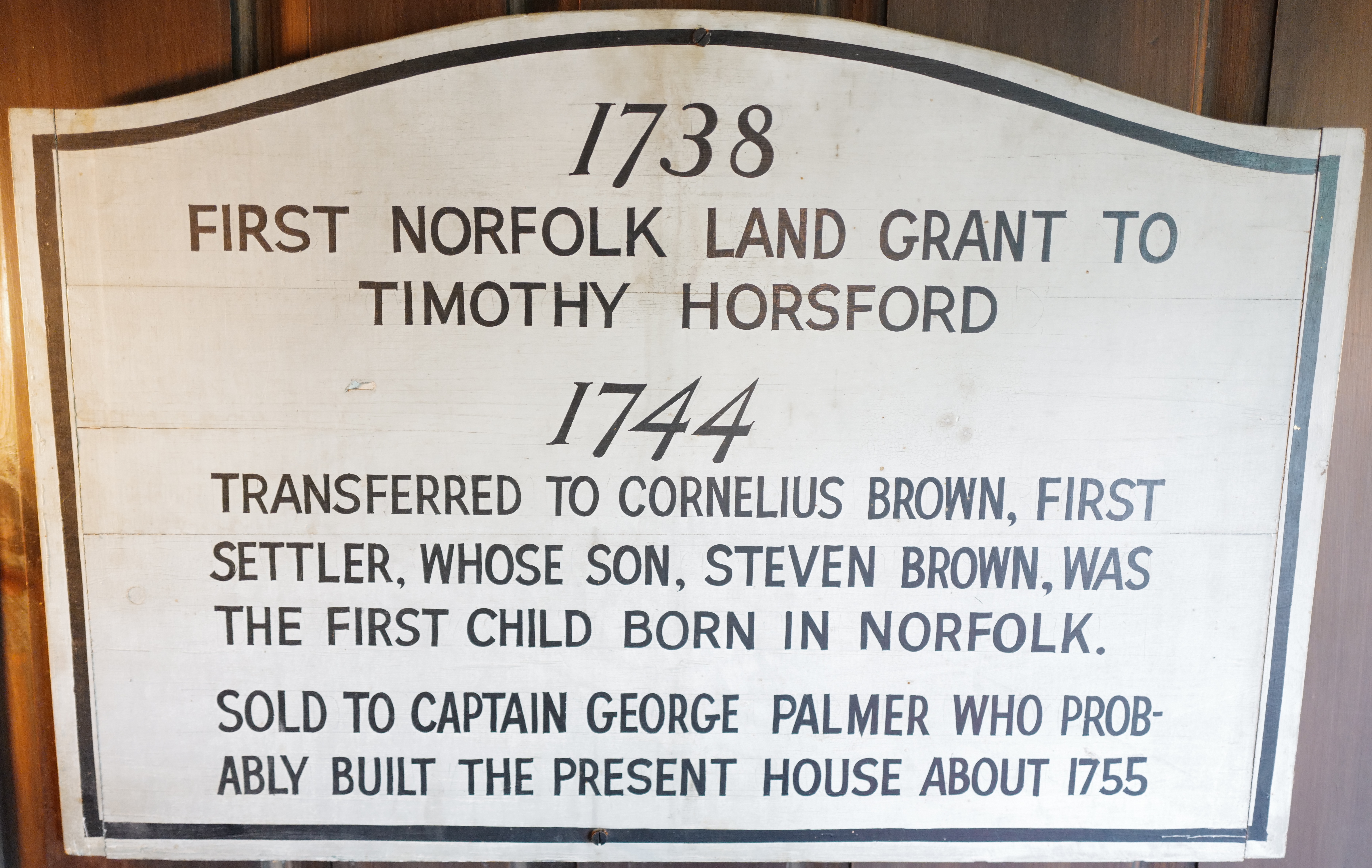The Capt. George Palmer House, c. 1755
This Old Norfolk House
by Michael Cummings Kelly
Approaching Norfolk from the west, just past the Blackberry River Inn (1763), the discerning motorist perceives on a gentle rise to the left an apparition sheathed in white. Spectral in appearance, the 1755 Capt. George Palmer House preens demurely, laying claim in its regal simplicity to being the oldest house still standing in Norfolk.

Longtime owner, Swedish-born Anita Mathewson, moved to New York City as a flight attendant for Pan American Airlines during the glamorous early days of international jet-setting. Anita had been working as a model when she met her future husband, John Mathewson, a pioneer developer of snowmaking equipment that he built and installed at ski resorts all over the world. John flew his own plane and could have lived most anywhere, but to paraphrase Anita, “Our good friends owned nearby Catamount Ski Area, and John suggested we consider moving to the country, where he could easily access his airplane and fly to his mountainous business destinations.”
Doubtful as she may have been in 1965 about leaving the glitter of New York for the hinterlands where she knew no one, Anita nevertheless found a pristine, pre-Revolutionary War, center chimney saltbox home situated on 200 acres on the outskirts of Norfolk. Just five weeks after their daughter Jill was born in Sweden, the Mathewsons moved into the Capt. George Palmer House on Locust Hill. Having raised her two daughters here and forged a successful career as founder and owner of Locust Lane Realty, Anita has never regretted leaving the big city to rusticate in Norfolk.
The Mathewsons purchased their home from Penelope Harris, who had owned it since the 1930s when she seamlessly added a felicitous new kitchen to the back of the house. Wisely, she left intact the original 18th-century portion of the house featuring multiple fireplaces (including two substantial cooking hearths with beehive ovens), wide board pine floors, original wood paneling and colonial details. Mindful of the antique treasure of which they had become custodians, the Mathewsons made necessary electrical and plumbing upgrades, but otherwise, respecting the house’s historic integrity, changed very little.
It was at George Palmer’s house on May 21, 1755, that 52 intrepid settlers and land speculators from the Hartford area drew random lots out of a hat giving them “rights” to 100-acre lots of land in the forbidding, deeply forested greenwoods of northwest Connecticut.
The dauntless first settlers cleared land and built sturdy, vernacular houses meant to last forever. By 1758, 43 families were established in the area, prompting Palmer and his compatriots to petition the state legislature in Hartford to legally establish a local government. To officially become a town, which they named Norfolk after a county on the east coast of England, these first citizens were required by the state assembly to build a church, house a school and raise a militia. George Palmer became Norfolk’s inaugural first selectman, headed a committee charged with building an ironworks on Great Pond (Doolittle Lake) and was appointed second captain of the Norfolk militia.
Yet, just eight years after George Palmer built his enduring, archetypal home on a hill overlooking the Blackberry River, he packed up and left Norfolk for good. His father, John Palmer, a Great Awakening revivalist preacher from Portland, Conn., had recently gathered a congregation of 100 believers close by in Canaan. In 1763, Reverend Palmer felt called by God to move his congregation to Stillwater, N.Y., outside Saratoga Springs. Son George abruptly sold his Norfolk house and land and dutifully joined his father in Stillwater, where he built another house and owned a sawmill. A street in Stillwater is named after Capt. Palmer, who during the Revolutionary War provided much needed equipment and supplies for George Washington’s Continental Army.
Entering the Mathewson house by a recessed downstairs doorway, a visitor is transported through an impressionistic scrim of history to the late 18th century. In a snug hideaway with the look and feel of a colonial tavern, a large rough-cut stone fireplace buttressed by a bulkhead of ceiling beams patinated with wood smoke beckons. It’s easy to imagine colonial travelers drinking by the welcoming hearth while their dinners slowly simmered over the comforting fire.
In 1777, after Burgoyne’s surrender at Saratoga, defeated Hessian soldiers were marched to Hartford along an arduous route that passed through Norfolk, where they camped overnight on the village green. Legend has it that one of the Hessian soldiers, likely a guest in the George Palmer House, had too much grog and unceremoniously threw his teapot into one of the big fireplaces. The scorched teapot was retrieved and kept in the house as a memento for years but was subsequently lost, enveloped by the tentacles of time.
After over a half century of loving stewardship and countless memorable moments in the Capt. George Palmer House, Anita Mathewson is perfectly happy right where she is. Historic houses live and breathe with atavistic enchantment and charm, making it emotionally difficult to separate the timeless essence embedded in a historic house from the heart and soul of the owner who cherishes it.
This is the first in a series of articles on 18th-century Norfolk houses. To date, close to 50 have been identified, spread over Norfolk’s 46.4 square miles.

